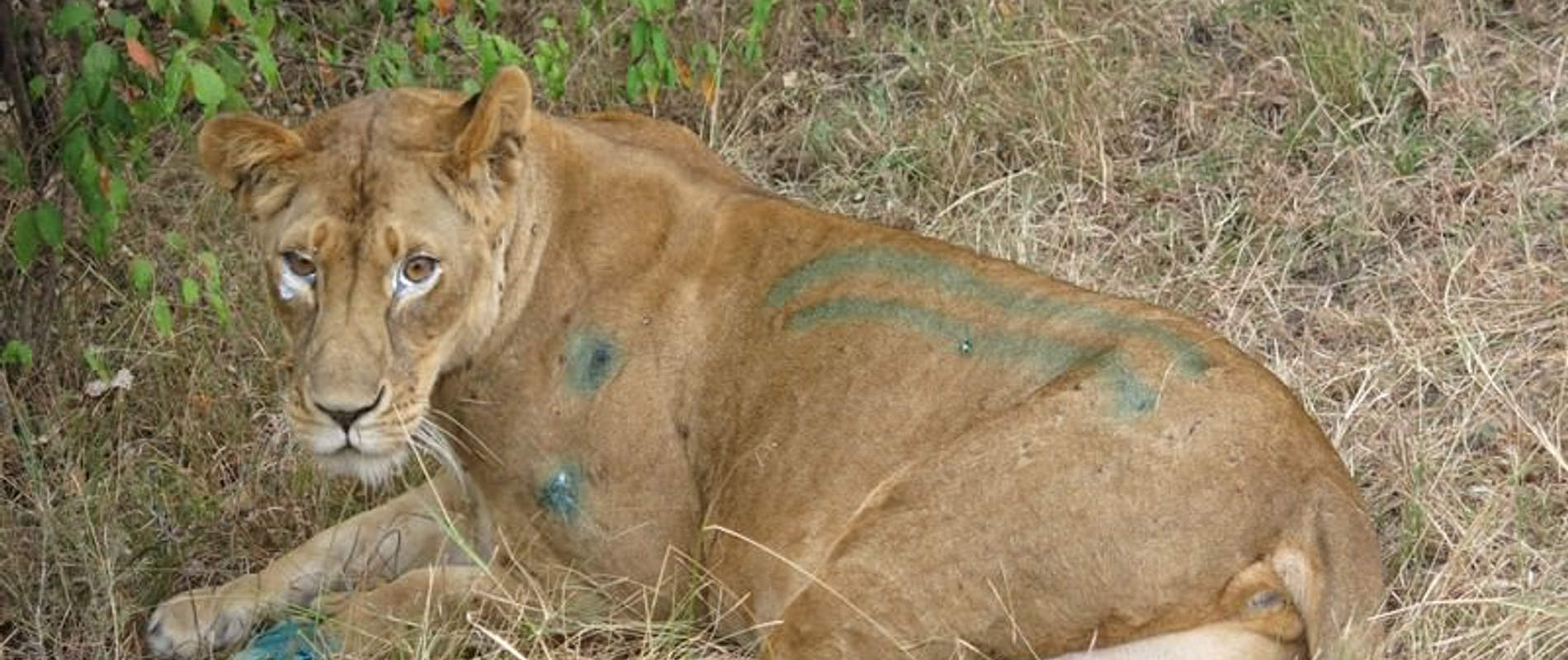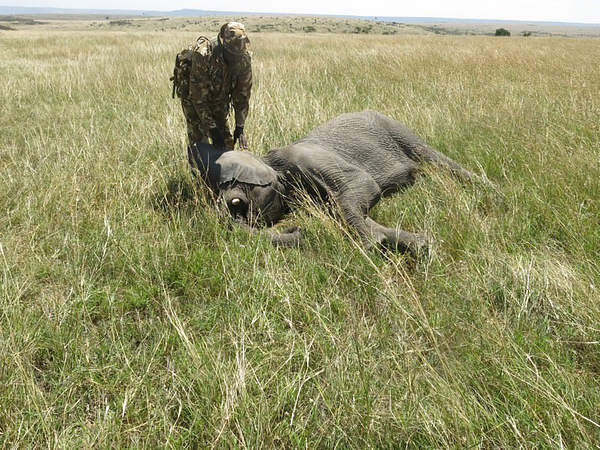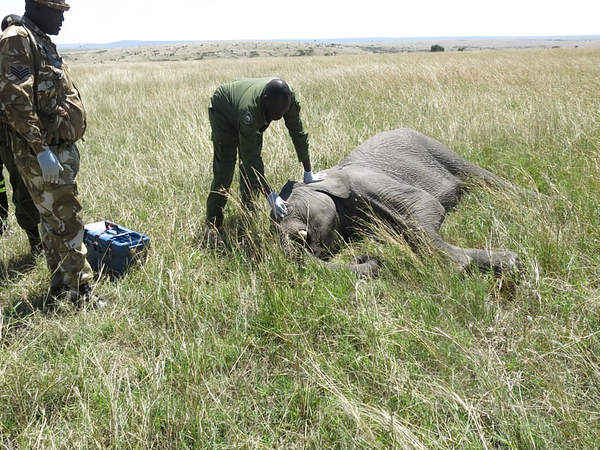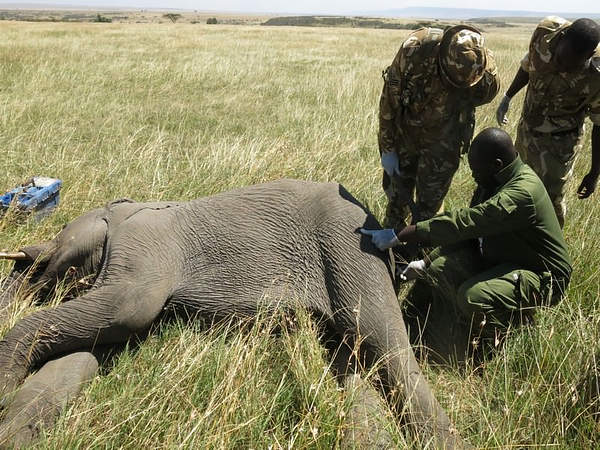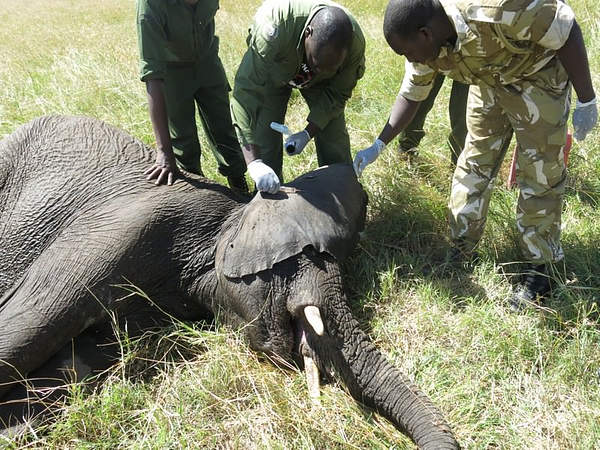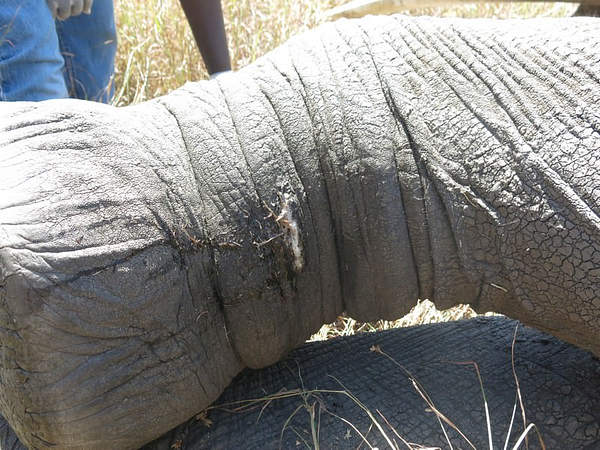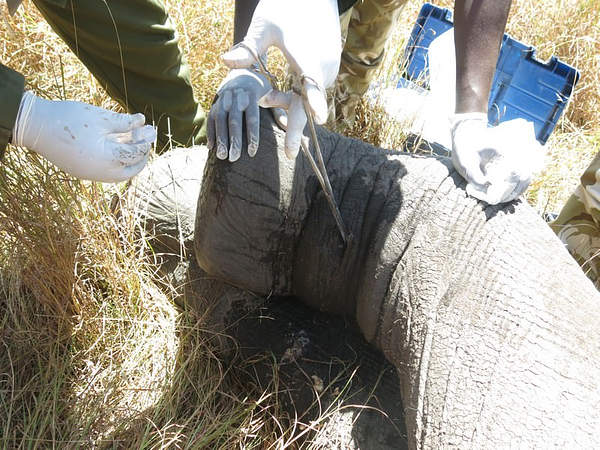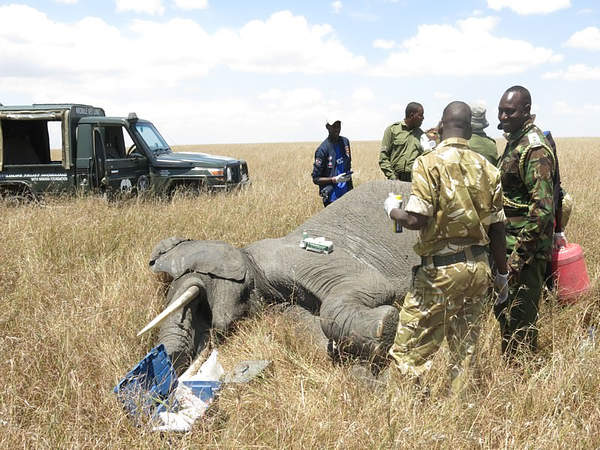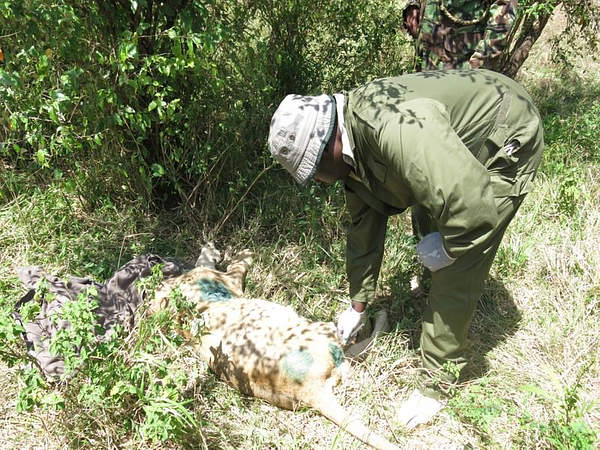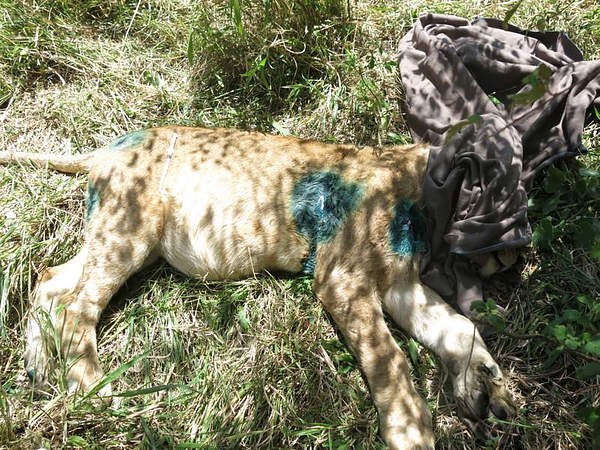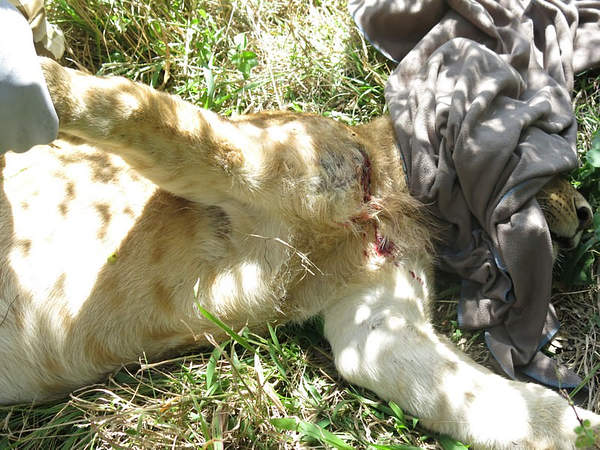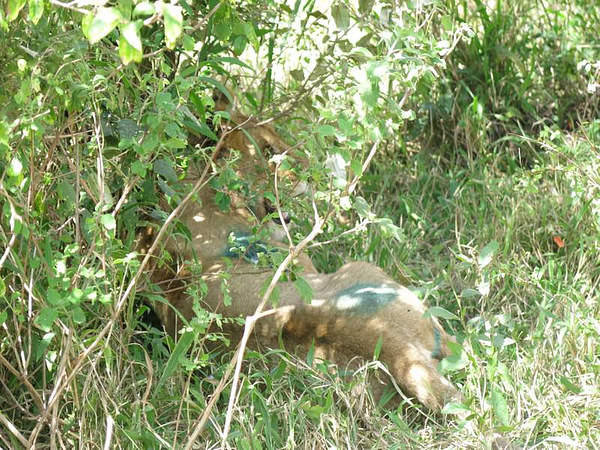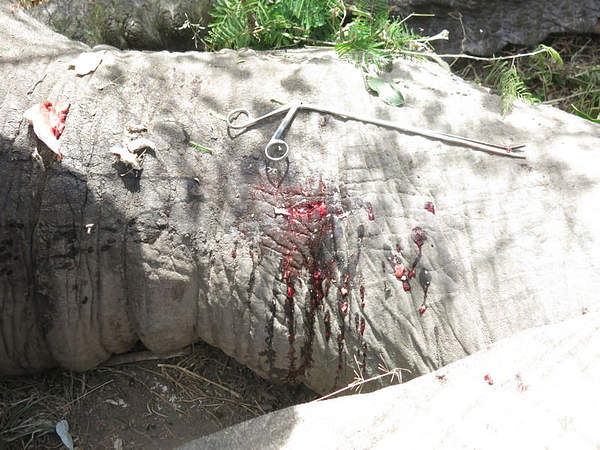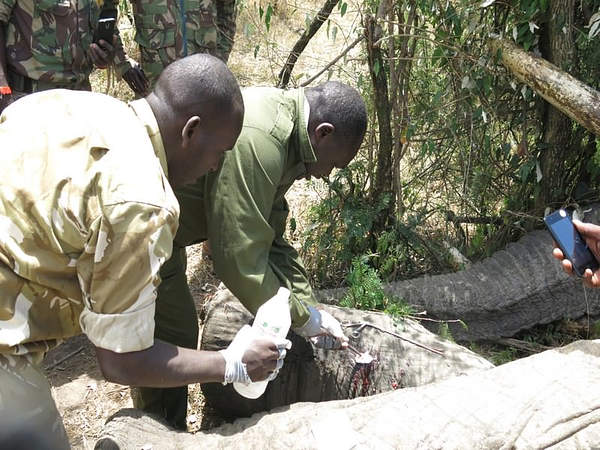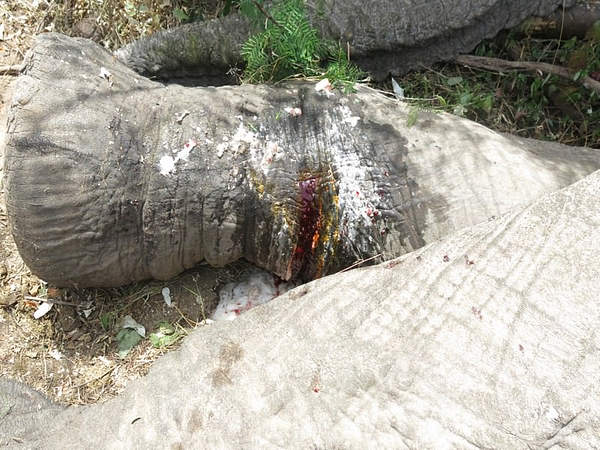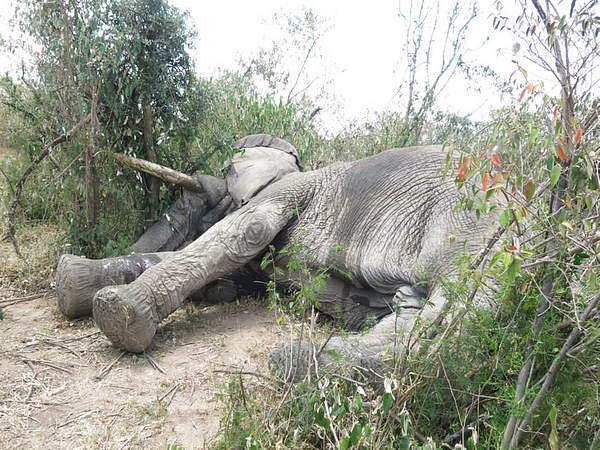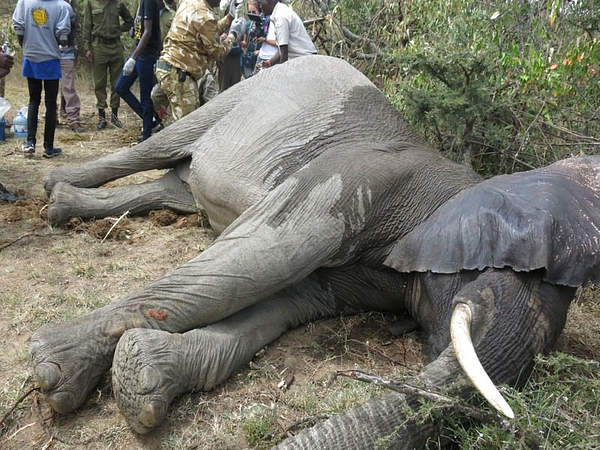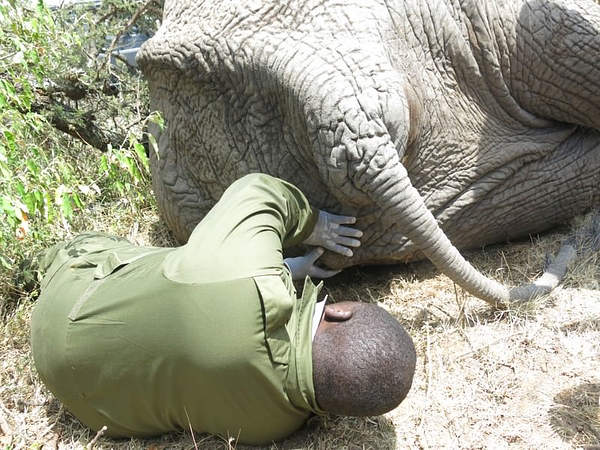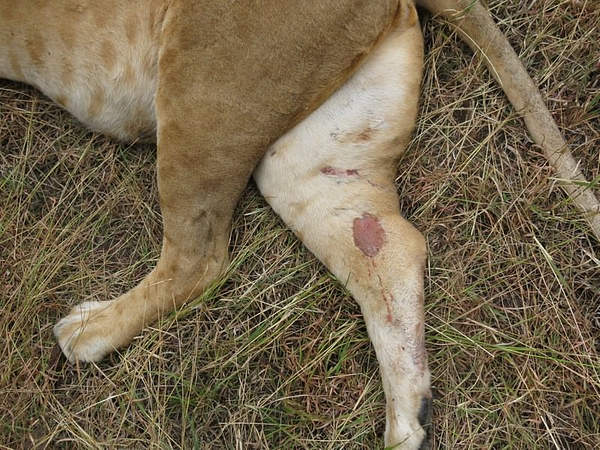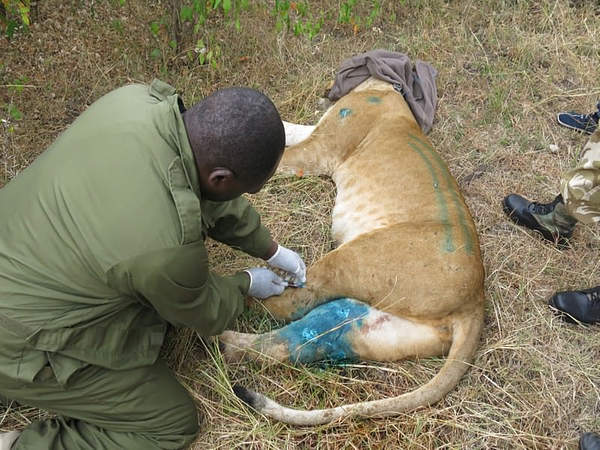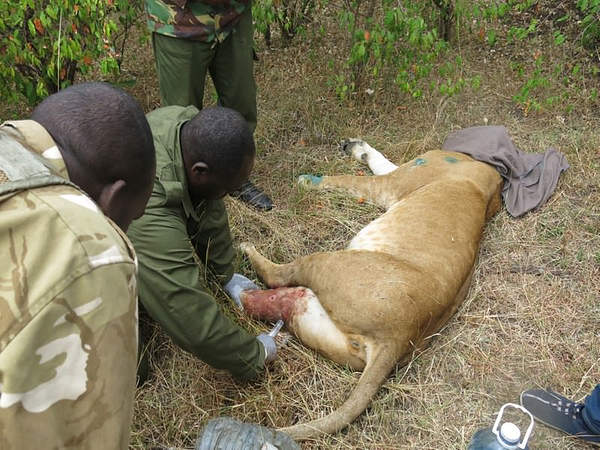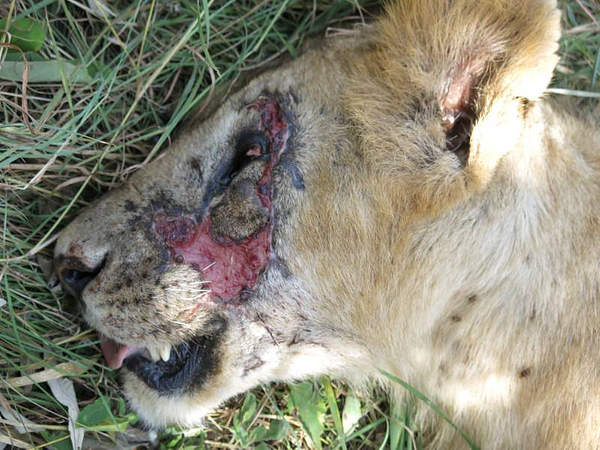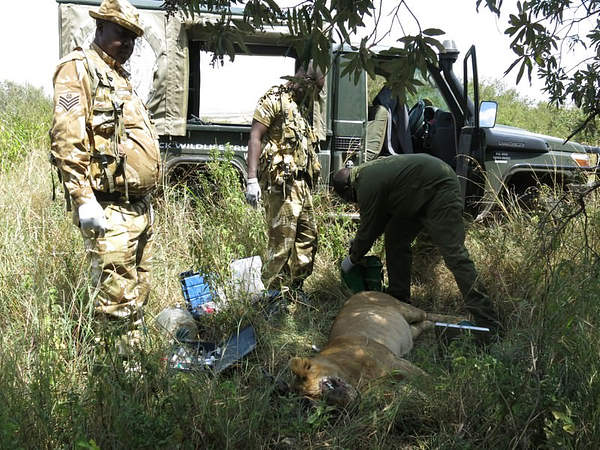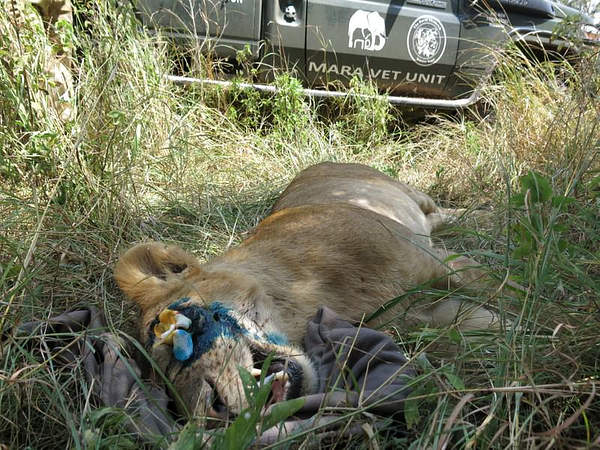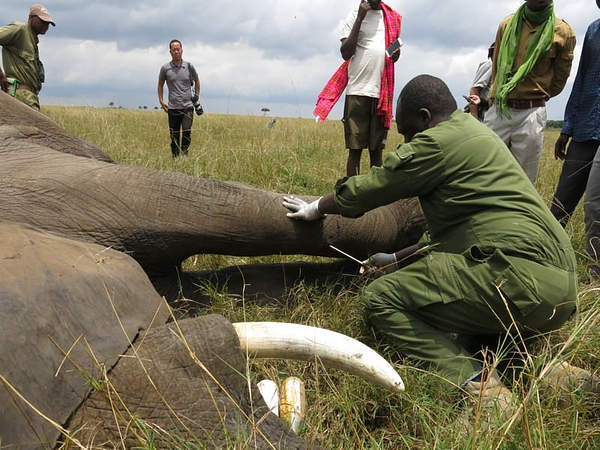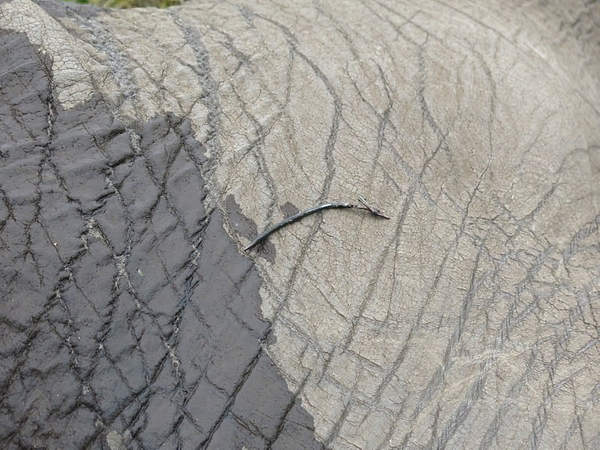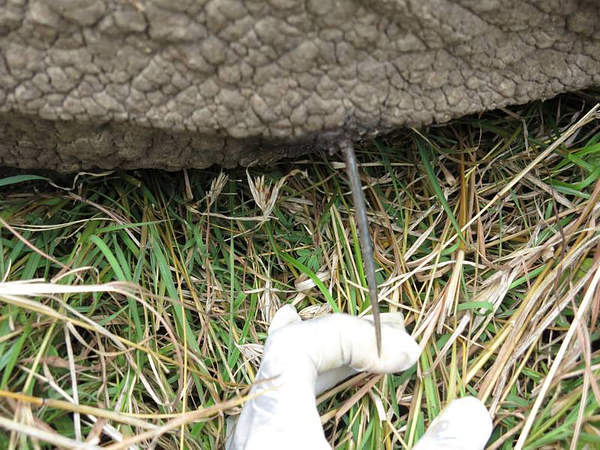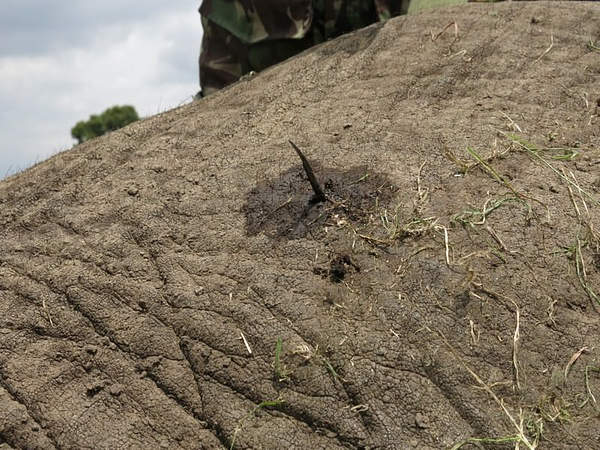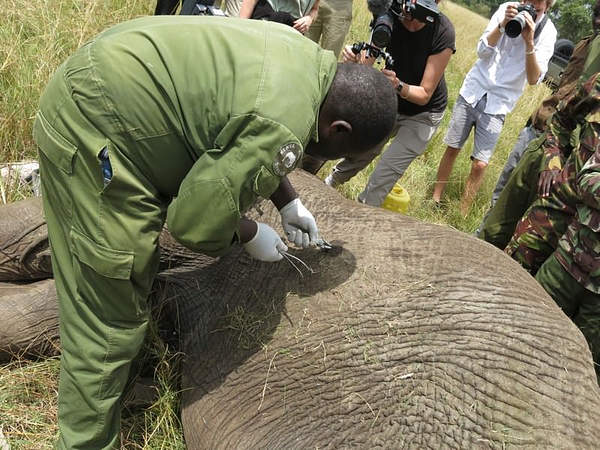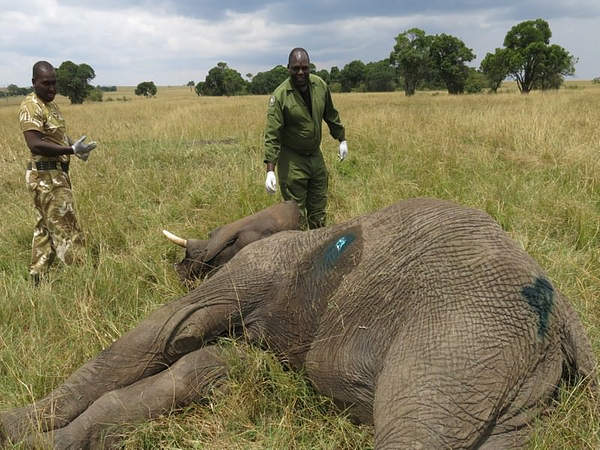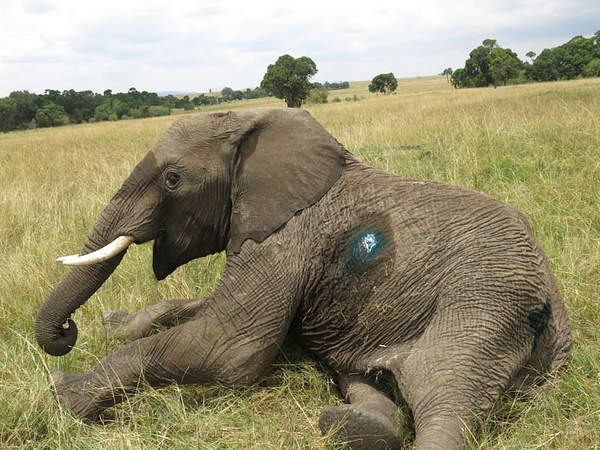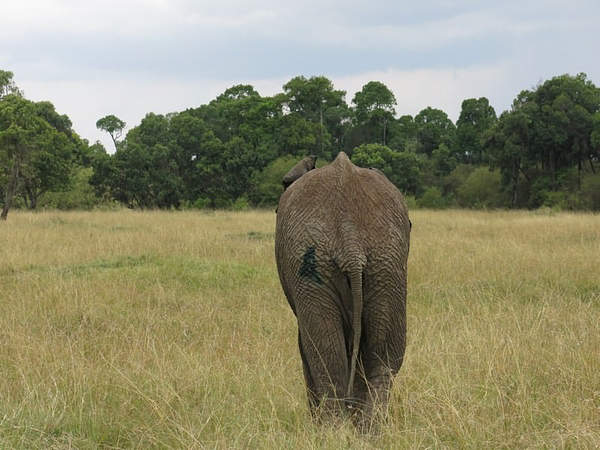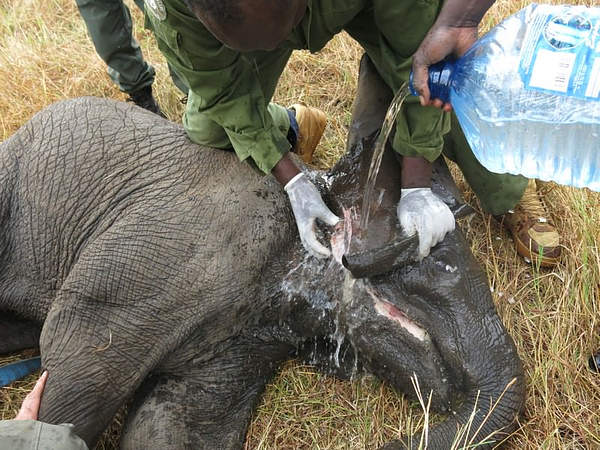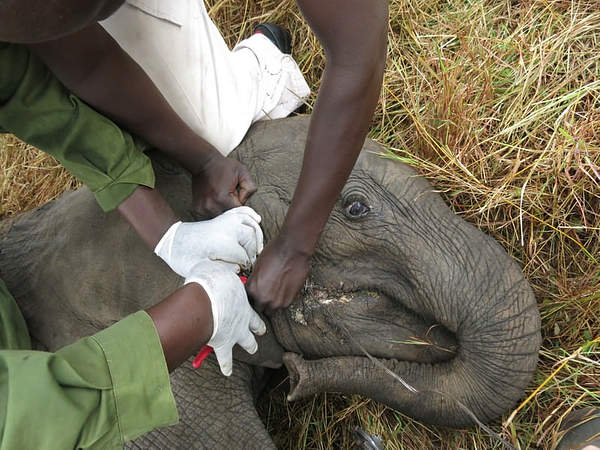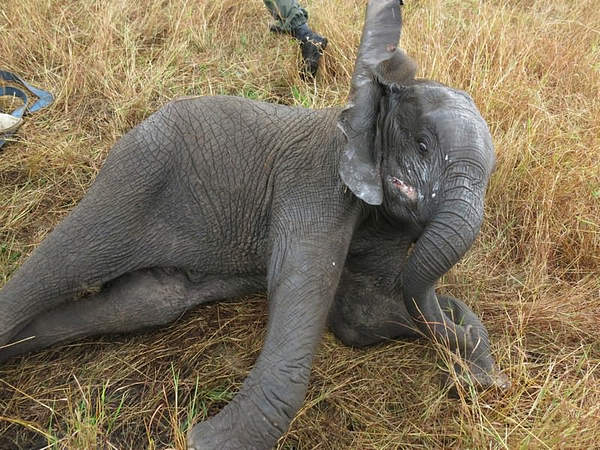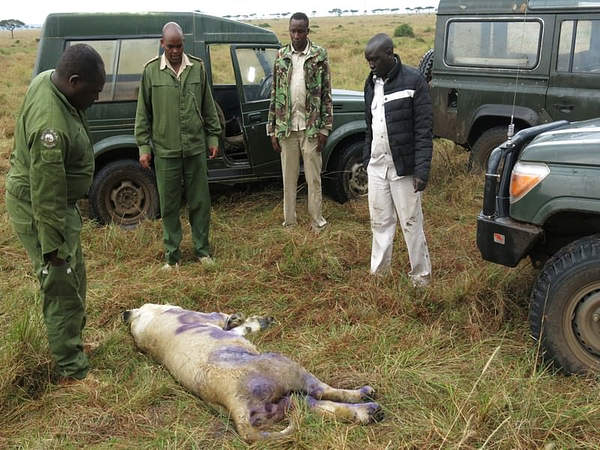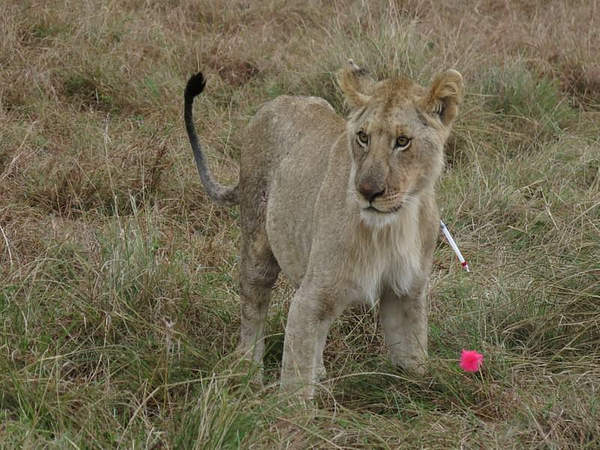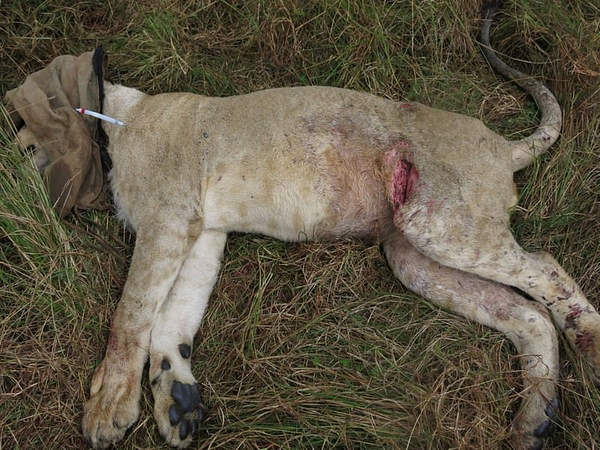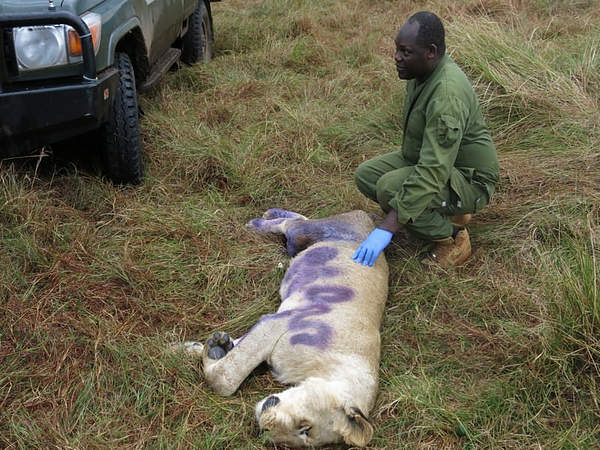The month under review was characterised by long dry spells with slight showers occurring towards the end. There is still plenty for wildlife to utilise with annual migration of wildebeests attracting many tourists. Elephants and lions formed the bulk of the species requiring intervention with one cheetah succumbing to injuries from a lion attack.
CASE#1 EXAMINATION OF A MALE LION
Date: 7th August 2018
Species: African lion
Sex: Male
Age: Adult
Location: Double Crossing (Masai Mara National Reserve)
History: This old male named Blackie was a brother to another male nicknamed Lipstick who died of old age earlier on in the year. He was seen limping by tour guides who called the Mobile Veterinary Unit for examination.

General observation and diagnosis: Blackie was spotted sleeping alone about one hundred meters away from his pride. When agitated to move, he stood and walked with a limping gait from his right hind leg. There was no obvious injury but the thigh muscles of his leg appeared wasted. This was considered to be a long term injury which damaged the nerves and other essential supplies to the muscles of this leg with resultant wasting.

Given his age and the nature of the damage, the team felt there was no need to intervene. He can live with the problem through his sunset years given that the pride is still helping him hunt. This was explained to the team on the ground and Blackie was left to relax in the shade.
CASE#2 INJURED MALE CHEETAH
Date: 7th August 2018
Species: Cheetah
Age: Adult
Sex: Male
Location: Balloon crossing area (Masai Mara National Reserve)
History: This lone male was seen with an injury on his right thigh by County rangers on patrol with a team of cheetah Researchers. They immediately called the Veterinary Unit for examination and possible intervention.
General observation, treatment and diagnosis: This male named Martin was found alone in the shade. He had an injury on his right thigh with the tip of his tail missing. These injuries, estimated to be three to seven days old, were reported to have been caused by territorial fights with rival cheetahs. The wounds were not infected and appeared clean.
The team felt this cheetah was out of danger and there was no need to stress him through immobilization. He was given 600mgs Clindamycin antibiotics remotely through a 3ml daninject dart. Darting was done from a vehicle and the drugs were delivered intramuscularly into the healthy thigh. The dart stuck for few minutes before dropping having delivered the intended dose. He moved on briefly after dropping the dart finally settling down in the shade a few meters away. The rangers were then advised to monitor him and report back on his progress.

Prognosis: Prognosis for full recovery is good, and he was reported to have brought down an adult impala a day after treatment.
CASE#3 RECUMBENT ELEPHANT
Date: 11th August 2018
Species: African elephant
Sex: Male
Age: 3.5 – 4 years
Location: Mara North Conservancy
History: This young bull was seen by Mara North Conservancy rangers on their normal patrol lagging behind from the family. They said he became disoriented with signs of acute progressive paralysis. They reported signs of spinal paralysis, posterior ataxia, and recumbency and finally complete paralysis within a short span.
Examination, treatment and diagnosis: The young bull was found on right lateral recumbency in a semi-comatose state. No major physical injuries were identified even after turning him over. He appeared to be struggling to breathe with an indication of respiratory muscle paralysis. Fully formed faecal balls were found on rectal palpation. Blood and fecal samples were collected and nothing unusual was detected on microscopy including the normal suspect bacteria and parasites. He had a small scratch at the tip of his trunk with mild bleeding.
He was intravenously given an infusion of Dextrose solution, to foster energy, and normal Saline, for limited rehydration. He was also doused with plenty of water to cool him down. Other medications include intraperitoneal administration of Amoxicillin antibiotics, intravenous administration of Dexamethasone anti-inflammatories and Butasol which is a tonic for regeneration of muscle activity. The improvement was insignificant and the young bull remained recumbent. He died a few hours from midnight from suspected respiratory failure.
Conclusion: It was tentatively considered this elephant got exposed to neurotoxic venom from a snake bite. Some neurotoxic snakes are found within the ecosystem with most victims suffering adverse paralysis and respiratory failure. The respiratory muscles become paralysed resulting in the death of the victim.
CASE#4 EXAMINATION OF A DEAD CHEETAH
Date: 13th August 2018
Species: Cheetah
Sex: Male
Age: Adult
Location: Hammerkop area (Masai Mara National Reserve)
History: The carcass of this big male was seen by tour guides on their morning game drives. They informed the mobile veterinary unit and the county security team for action.
General observation and autopsy: The carcass of this male was found intact near a lugga. He was a mature healthy male in his prime age. Cheetah researchers based in the Mara could not identify him and was thought to have been new in the area, possibly trailing the wildebeests coming from Serengeti. He had bite wounds on his belly and neck which appeared to have been inflicted by a larger carnivore. Rigor mortis had not set in and he was estimated to have died less than six hours before discovery.

On opening the carcass, the following was noted: The muscle cover was adequate and this male was in good body condition prior to death. The lower abdomen had deep bite wounds accessing the peritoneal cavity, with haematomas forming and puncture of peritoneum noted. There were deep bite wounds on his neck leading to fracture of the cervical vertebrae and damage to the spinal cord at this level. Nothing unusual was seen on other areas.
Conclusion: The post mortem picture showed this cheetah was attacked by a bigger carnivore most likely a lion. The fracture of the cervical vertebrae and by extension the spinal cord lead to his immediate death.
CASE#5 INJURED BULL ELEPHANT
Date: 18th August 2018
Species: African elephant
Age: Adult
Sex: Male
Location: Masai Mara National Reserve (Talek sector)
History: This bull was seen walking with difficulty by Mara Mobile Veterinary team as they were going to attend to an injured lion cub. He showed lameness on his left front limb.

Immobilization, examination and treatment: The bull was spotted isolated in an open field and was seen walking with pain and lameness. Restraint was achieved chemically by use of a 16mgs Etorphine Hydrochloride delivered through a 3ml daninject dart. Darting was done by vehicle. It took ten minutes for the drugs to take full effect with this bull assuming right lateral recumbency.
Examination revealed a relatively fresh wound on the posterior aspect of his carpal joint. The injury was restricted to soft tissues, and was caused by a spear. The wound was debrided with Hydrogen Peroxide and gauze swab, rinsed with clean water and disinfected with Tincture of Iodine. Green clay was then packed into the wound. Additional treatments include parenteral administration of Amoxicillin antibiotics and Flunixin Meglumine anti-inflammatories.

Reversal and prognosis: Reversal was achieved by intravenous administration of 42mgs Diprenorphine Hydrochloride delivered through a prominent ear vein. He rose up within four minutes after reversal and walked away. Prognosis for full recovery is good.
Our Mobile Vet Units are in the field every day saving wild lives
CASE#6 INJURED LION CUB
Date: 18th August 2018
Species: African lion
Age: Approximately 8 months
Sex: Male
Location: Rhino Ridge (Masai Mara National Reserve)
History: This lion cub, in a pride of eight members, was seen by a tour guide with injuries who immediately informed the Mobile Veterinary Unit for action.

Immobilization, examination and treatment: He was found in a small bush, close to a stream, with other members of the pride having recently fed on a wildebeest. His right front leg appeared injured and he walked with difficulty. He had a wound near his shoulder. Immobilization was achieved by use of a combination of 2mgs Medetomidine Hydrochloride and 100mgs Ketamine Hydrochloride delivered through a 3ml daninject dart. Darting was carried out from a vehicle with this cub becoming fully anaesthetized after ten minutes. The other pride members moved away on approach and gave the team a chance to work on this cub.
He appeared to have been injured during an attack by a rival pride, with a deep and infected bite wound on his right shoulder. The injury was about a week old with purulent stuff beginning to accumulate. The wound was probed and all pus drained out. All necrotic tissues were debrided with help of Hydrogen Peroxide and gauze swab. Tincture of Iodine was used for disinfection with Cloxacillin antibiotic being infused to prevent sepsis. Additionally he was given 1500mgs Amoxicillin antibiotics intramuscularly.
Reversal and prognosis: Reversal was achieved by intramuscular administration of 12.5mgs Atepamezole Hydrochloride one hour after immobilization. He woke up after eight minutes to join the rest of the pride members. Prognosis for full recovery is good.
CASE#7 INJURED ELEPHANT BULL
Date: 20th August 2018
Species: African elephant
Sex: Male
Age: 45-50 years
Location: Siana/Olarro conservancy
This big bull named Oloropile treated twice before in the last four years is one among few very old elephants still roaming the Mara plains. He was seen limping from his front right leg with a small but discharging wound on the medial side above the carpus by the Elephant Aware team. His leg also appeared swollen. They called the Mobile Veterinary Unit for intervention.

Immobilization, examination and treatment: Oloropile was found in a small thicket with a colleague browsing peacefully. His right front leg appeared swollen with a small discharging wound on the medial aspect above the carpus.
Immobilization was achieved by use of 17mgs Etorphine Hydrochloride delivered through a 3ml daninject dart. Because of the terrain, darting was done on foot. It took this bull ten minutes to be fully anesthetised and he assumed sternal recumbency. He was gently pushed to right lateral position for comfort and ease of examination. He had a slightly septic spear wound on his right leg estimated to be approximately three days old.
The wound was probed and debrided with the help of Hydrogen Peroxide to remove as much necrotic debri as possible. It was then rinsed with clean water before Tincture of Iodine was used to disinfect the wound. Oxytetracycline spray was applied with green clay being finally packed in to the wound. Other treatments include parenteral administration of 30000mgs Amoxicillin antibiotic and 5000mgs Flunixin Meglumine anti-inflammatory.

Reversal and Prognosis: Reversal was achieved by intravenous administration of 48mgs Diprenorphine Hydrochloride through a prominent ear vein. He woke up in five minutes, posed for a while and calmly walked away to join his colleague. He is expected to make full recovery.
CASE#8 INJURED ELEPHANT COW
Date: 20th August 2018
Species: African elephant
Sex: Female
Age: Adult
Location: Olarro Conservancy
History: This elephant cow was seen with a wound on her left rump by Olarro security patrol team with the report reaching the Veterinary Unit through their management.
Immobilization, examination and treatment: She was found with a big herd browsing at the top of a hill within the conservancy. It was difficult to approach the herd by vehicle and was equally challenging on foot. Services of a helicopter were available and were utilized in assessment. She was seen with an injury on her left rump. Restraint was achieved chemically by use of 15mgs Etorphine Hydrochloride delivered remotely through a 1.5ml daninject dart. Darting was done from a helicopter. She was gently pushed towards an open plain area soon after darting. She became fully anesthetised after ten minutes assuming left lateral recumbency.
After making sure she was stable, a thorough examination was carried out. This was an old arrow wound which was healing with fibrosis. Probing was negative for foreign body. This wound was debrided with the help of Hydrogen Peroxide and gauze swabs. Tincture of Iodine was used for to disinfect the wound after being rinsed with clean water. Finally Cloxacillin ointment was infused. Other treatments include parenteral administration of Amoxicillin antibiotics and Flunixin Meglumine anti-inflammatory.

Reversal and Prognosis: Reversal was achieved by administration of 36mgs Diprenorphine Hydrochloride through a prominent ear vein. She woke up within three minutes and went up the hill where other herd members were. Prognosis for full recovery is good.
CASE#9 INJURED LIONESS
Date: 21st August 2018
Species: African lion
Sex: Female
Age: Adult
Location: Naboisho Conservancy
History: This lioness with two four month old cubs was seen with injuries on her right hind leg by Naboisho Conservancy rangers. They contacted the Mobile Veterinary Unit for help.

Immobilization, examination and treatment: She was found lying a few meters from her cubs, which were in a small thicket. Her right hind leg was swollen with obvious injuries. When agitated to move, she did so hardly placing weight on the affected leg and seemed to be in a lot of pain.
Restraint was achieved chemically by use of a combination of 6mgs Medetomidine Hydrochloride and 200mgs Ketamine Hydrochloride delivered through a 3ml daninject dart. Darting was done from a vehicle. The drugs took full effect after twelve minutes whereupon a blindfold was applied. Examination revealed a deep wound on her right thigh caused by a bite from other lions. Though deep, the injuries were limited to soft tissues. These were 3-4 day old wounds with sepsis starting to set in.
All the wounds were thoroughly probed with all necrotic tissues and pus being removed. Hydrogen Peroxide and gauze swabs were used for debridement before being rinsed with clean water and subsequent disinfection with Tincture of Iodine. Additionally, Cloxacillin ointment was infused and Oxytetracycline wound spray was applied topically. Other treatments include parenteral administration of 3000mgs Amoxicillin long acting antibiotics and 16mgs Aexamethasone Sodium anti-inflammatories.

Reversal and prognosis: Reversal was achieved by intramuscular administration of 15mgs Atepamezole Hydrochloride one hour after immobilization. She woke up after ten minutes and retreated to where her cubs were hiding. Prognosis for full recovery is good. She made a kill a day after treatment.
CASE#10 INJURED LION
Date: 22nd August 2018
Species: African lion
Sex: Male
Age: Sub adult
Location: Sarova Sun downer (Masai Mara National Reserve)
History: This young male was spotted by tourists early in the month with a nasty injury on his face who informed the Mobile Veterinary Unit. However, efforts to locate him immediately were futile as he was a nomadic male. The team finally located him ten days later.
Immobilization, examination and treatment: He was seen in the company of a colleague, assumed to be his brother, feasting on a fresh zebra kill. He bore an injury on the left side of his face suspected to have been caused by fights with other lions. Restraint was achieved chemically by use of a combination of 4mgs Medetomidine and 200mgs Ketamine Hydrochloride delivered through a 3ml daninject dart. Darting was done from a vehicle. It took eight minutes for full anaesthesia to be realised.
He was then moved to a shade, an eye ointment against desiccation was applied to both eyes and a blind fold was put in place. Examination revealed, he suffered a nasty soft tissue injury most likely from an attack by other lions on his face. The wounds were dry and clean. The hanging skin was trimmed and the wounds were wiped with sterile gauze swabs soaked with normal Saline. Tincture of Iodine was used as a disinfectant before Oxytetracycline spray being applied topically. Additionally, this young male received 2250mgs Amoxicillin antibiotic intramuscularly to prevent infection.

Reversal and prognosis: Reversal was done one hour after immobilization by use of 15mgs Atepamezole Hydrochloride given intramuscularly. He rose after ten minutes to join his colleague. Prognosis for full recovery is good. He made another zebra kill two days after treatment.
CASE#11 INJURED ELEPHANTS
Date: 27th August 2018
Species: African elephant
Sex: Female and a male
Age: Adult female and a sub adult bull
Location: Mara North Conservancy
History: The two elephants were part of a family of twelve that had crossed over to a community area the previous day to crop raid. Retaliation by the locals saw two members of this family being shot with arrows. Mara Elephant Project with Mara North Conservancy monitored these elephant as they drove them out the community area to the conservancy. Two of them had arrow wounds and the Mobile Veterinary Unit was called to intervene.
INJURED ELEPHANT COW
This was an adult female nursing a young calf. She appeared to be in a lot of pain and an arrowhead could be seen sticking out from her right ear flap and upper left thorax. She also had a swollen left front leg.

Immobilization, examination and treatment: Immobilization was achieved by use of 16mgs Etorphine Hydrochloride delivered through a 3ml daninject dart. Darting was done from a vehicle with this elephant going down on her right side after ten minutes. Examination revealed, two arrowheads stuck in her body, one on her right ear flap and another on her left upper abdomen. The swollen front leg had an old injury suspected to have been caused by an arrow.
The barbed arrowheads were gently worked out. The resultant wounds were debrided with the help of Hydrogen Peroxide and gauze swabs. Clean water was used for rinsing with Tincture of Iodine being applied for disinfection. Cloxacillin ointment and Oxytetracycline spray were applied to prevent sepsis. The older wound treated the same way. Additional treatments include parenteral administration of Amoxicillin antibiotics and Flunixin Meglumine anti-inflammatories.

Reversal and prognosis: Done by administration of 42mgs diprenorphine hydrochloride intravenously through a prominent ear vein. She woke up in four minutes to join the other family members. Prognosis for full recovery is good.
INJURED ELEPHANT BULL
This young male had an arrowhead stuck in his left abdomen. He appeared to be in pain but kept pace with the rest of the herd.
Immobilization, examination and treatment: Immobilization was achieved by use of 13mgs Etorphine Hydrochloride delivered through a 1.5ml daninject dart. Darting was done from a vehicle. This was done after the family had re-grouped and calmed. It took eight minutes for the drugs to take full effect with this young bull assuming left lateral recumbency. The matriarch assumed to be his mother was very protective of him and tried to pull him up. She was gently driven away with the help of vehicles.

This young bull had to be turned over in order to access the arrowhead and give treatment. The barbed arrowhead was gently pulled out with the resultant wound being managed as the first elephant. He also received intramuscular injection of 22500mgs Amoxicillin antibiotics and 5000mgs Flunixin Meglumine anti-inflammatories.
Reversal and prognosis: Reversal was done by intravenous administration of 36mgs Diprenorphine through a prominent ear vein. He woke up in three minutes with the protective matriarch coming for him and leading him to where other family members were waiting. Given that none of the arrows were poisoned, both elephants are expected to make full recovery.
CASE#12 SNARED ELEPHANT CALF
Date: 29th August 2018
Species: African elephant
Sex: Male
Age: Approximately 1 year.
Location: Mara Triangle Conservancy
History
This calf had been the night before by Mara Conservancy Rangers with a tight wire snare between his upper and lower jaws. They called the Veterinary Unit for intervention. He disappeared with the herd into a bushy hill and frantic efforts to search for him were made in vain. As night fell the search operation was stopped. He was seen the next day, this time early, and the teams, including the Mara Triangle Management and the Mare Elephant Project, responded immediately.

Observation, capture and treatment
This calf was seen with his family members within a bigger herd of about 30 elephants. Though his body condition was good, the snare was tight and had injured the lips of the mouth at the commissures. The snare went round behind the head injuring both ear flaps. He was physically restrained, with the helicopter isolating him from his mother and his family. Ropes were used to restrain him before the tight wire snare could be cut loose. This was a braided wire snare that had been in place for at least one week.
The resultant wounds were debrided with Hydrogen Peroxide, rinsed with clean water and Tincture of Iodine disinfectant was applied. Additionally, he received 4500mgs Amoxicillin antibiotics and 1500mgs Flunixin Meglumine anti-inflammatories. He was then released and guided towards his mother who was in a nearby bush, within few minutes they were re-united.

Prognosis: Prognosis for full recovery is good. Removal of the snare was a big relief and he should be able to suckle and feed without any further hindrance.
CASE#13 INJURED LION
Date: 29th August 2018
Species: African lion
Sex: Male
Age: 1.5-2 years
Location: Mara Triangle
History
This young male was seen injured by the Mara Triangle Rangers who called the Veterinary Unit for help.

Immobilization, examination and treatment: He was found feasting on a wildebeest kill with his mother and another female. He had severe bite wounds on his left precruris and right thigh. Other bites were seen on his tail and hind limbs. Restraint was achieved chemically with the use of a combination of 4mgs Medetomidine Hydrochloride and 190mgs Ketamine Hydrochloride delivered through a 3ml daninject dart. Darting was done from a vehicle with this lion becoming fully anaesthetized after eight minutes. Eye ointment against desiccation was applied before the lion was blindfolded.
Examination revealed bite wounds distributed around body with serious ones on his left precruris and right thigh. The bites were caused by other carnivores, most likely hyenas. These wounds were approximately three days old. They were debrided with Hydrogen Peroxide and gauze swabs with all necrotic tissues being removed. Tincture of Iodine was applied for disinfection with Cloxacillin ointment being infused to prevent sepsis. Additionally, he received 40mgs Ivermectin Parasiticide subcutaneously and 3000mgs Amoxicillin antibiotics intramuscularly.
Reversal and prognosis: Reversal was achieved by intramuscular administration of 15mgs Atepamezole Hydrochloride one hour after immobilization. He woke up after ten minutes and moved towards where his mother was. This lion has a good chance of full recovery. Though it will take some time for him to fully recover, he is in a pride that actively hunts and will assure him of food. The team was advised to keep watch and report on his progress.
Acknowledgement
Report by KWS Vet Dr Campaign Limo. The Mara Mobile Veterinary Unit would like to thank everyone who assisted and contributed in whichever way towards intervention of wildlife cases over the month. Thanks to Minara Foundation through the DSWT for their continued funding to the unit. Thanks too to KWS for offering technical support to the unit.
